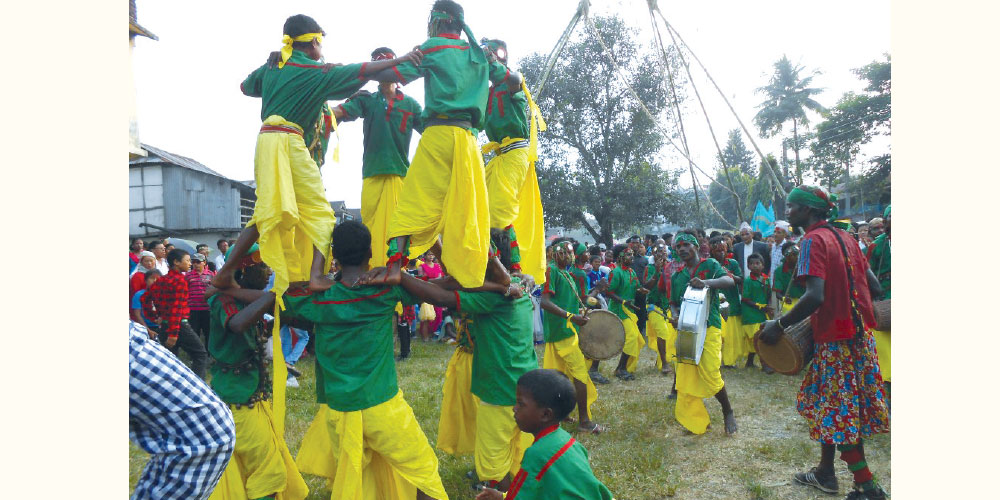
SATV Urlabari, Oct. 7: The minority Santhal community residing in Morang and Jhapa districts is currently preparing for their traditional ethnic dance ‘Dasai’.
Nature-worshipper Santhals have been celebrating Dashain and Tihar by performing the Dasai dance since ancient times. They perform Dasai dance in their villages from Vijayadashami to Purnima.
In the fairs held in the villages during Dashain and Tihar festivals, the Dasai dance by Santhal youth is the main attraction. Pradeep Dhimal, a local, said, “Dashain does not look complete without the Dasai dance of Santhals at the fairs.”
According to local Tejan Khadka, non-Santhal people also participate in the Dasai fairs, fostering ethnic harmony within the community.
Gore Hemaran from Urlabari-8 said, “The Dasai dance has preserved the cultural and ethnic identity of the Santhal people. Recently, the local government has started providing some support to preserve our culture and traditions. Despite having our language, festivals, religion, culture and attire, the Santhal community has been facing religious and cultural challenges.”
He said that due to poverty, many Santhals had been vulnerable to religious conversion.
The Santhals perform this dance not only during Dashain but also during other festivals like Sorai, dressing in their traditional attire. The Santhals are extremely poor. Once hunters and farmers who lived off the land, they now struggle for survival, relying on subsistence farming and working on others’ lands.
Baidhyanath Soren from Urlabari-9 said that the Santhals played a vital role in making the land of the Tarai region arable and establishing settlements until the 1970s. However, after selling their land to the people who migrated to the plains from hills, many Santhals have now become landless. He said that due to a lack of education and awareness, former landowners had now become landless.
Santhal dances are performed in their native language, wearing their traditional Gai Jatra-style attire. They wear brightly coloured shirts, dhotis, peacock feathers and headgear made of mirrors and earrings. They also tie various types of jewelry around their bodies. The dancers, all male, move in rhythm with the music, dancing in coordinated groups. Women play an equally active role in motivating and energising the male dancers. During mid-performance, women often throw puffed rice and the male dancers try to catch it with their mouths while proving their bravery by doing so without using their hands.
During the dance, the dancers demonstrate the power of the goddess Kali by facing whips and sticks fearlessly. They perform stunts like blowing fire by putting kerosene in their mouths, burying their heads in the ground and stacking people on top of one another to form two- or three-tiered human pyramids. They add excitement to the dance by enduring hundreds of whiplash. Elder Santhals claim that those dancing under the influence of Kali’s power remain unaffected by the strikes. According to them, the dancers practice these skills in advance.
Like the Dhimals, Rajbanshis and Tajpuriyas living in eastern Nepal’s Tarai, the Santhals are an ancient ethnic group. However, due to the government’s lack of attention to their education and human development, they are facing increasing economic challenges.
Musui Hemaram, president of the Santhal community in Urlabari, said, “Our children have forgotten their language. They do not know about our festivals. The government has banned hunting with bows and arrows in the forests and since the introduction of the concept of community forest, we are no longer allowed to enter the forests.”
He further said that now the use of bows and arrows has become merely symbolic during festival times.
Historically, the Santhal people were hunters who used bows and arrows, gathered wild roots and tubers, raised livestock and practised limited agriculture. However, they are now worried as their traditional practices and customs are gradually disappearing.
The village chief of Urlabari, Shivraj Kisku, recalling the stories told by his grandfather, said, “We have lived here for 11 or 12 generations. They say we cleared the jungle for people to settle in this area. But now, of the 225 Santhal families in Urlabari, 125 do not own any land.”




